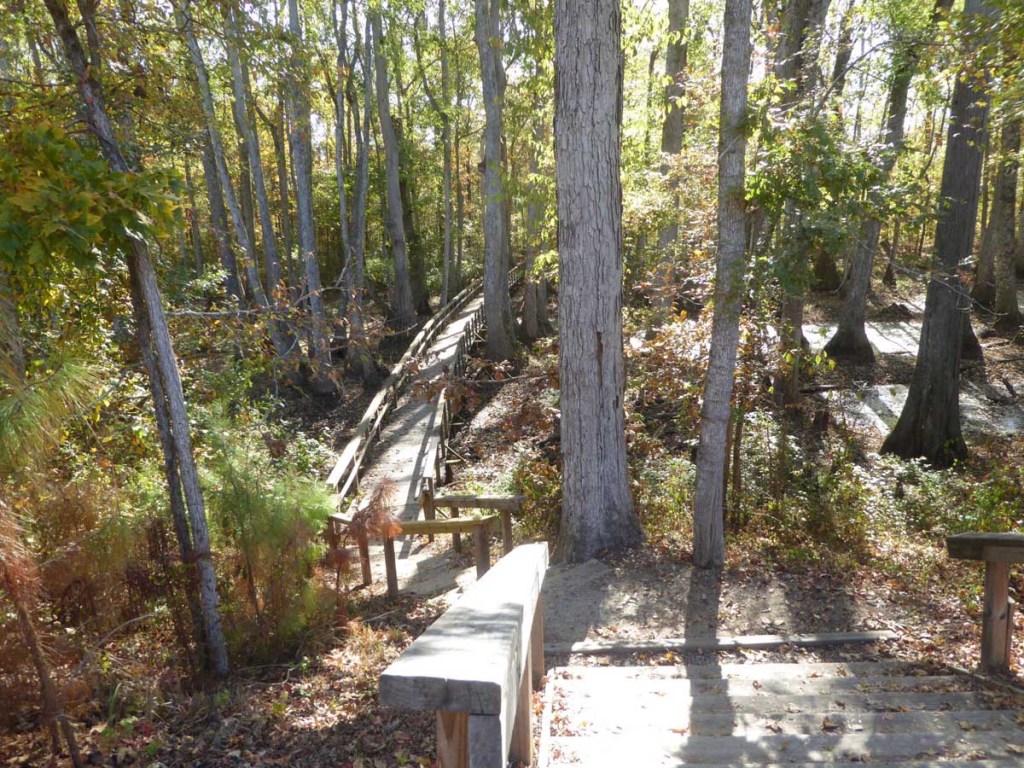Exploring the Natchez Trace Parkway
Published 10:00 am Thursday, April 18, 2024

- The Cypress Swamp pull-off leads to a .4 mile loop trail through bald cypress and water tupelo trees. The water level depends on the season and rainfall.
The Natchez Trace (trace in this sense is a path created by repeated use) connecting Nashville, Tennessee with Natchez, Mississippi, is a passageway established thousands of years ago by migrating herds of buffalo and other grazing animals.
The trace was later utilized by Native Americans, explorers and settlers.
It is perhaps best-known today as the return trail for boatmen called “Kaintucks” who, from the early 1800s to mid-1820s, floated down the Mississippi River on wooden flatboats filled with goods to sell after which the boats were sold there for lumber. The boatmen then walked or rode horses back north. Rather than follow the Mississippi River, the trace headed northeast and generally required a little over a month to reach Nashville.
Despite the path’s generally poor condition, Congress established the trace as a post (as in mail) road in 1800. As passage usage increased and the road underwent improvements, entrepreneurs established inns, called “stands,” that offered food and lodging along the way. While most foot traffic headed north, large numbers of slaves were marched south along the trace to be sold at auction to plantation owners.
Natchez Trace National Scenic Trail was established in 1983 and is one of 11 national scenic trails managed by the National Park Service. The trail totals 60 miles and is comprised of five segments ranging in length from 3 to 26 miles. For those interested in driving rather than hiking, the 444-mile Natchez Trace Parkway parallels the old trace. The parkway was established as a unit of the National Park Service in 1938, but not officially completed until 2005. A leisurely drive along the two-lane road with marked pullouts, exhibits, information boards, walking trails and visitor centers offers a lesson in American history. Maximum speed on the parkway is 50 mph, so it’s a slow go, but this is appropriate with so much to experience along the scenic road.
The two of us have enjoyed over five decades of travel including driving the full length of the Blue Ridge Parkway at least a dozen times, but it wasn’t until fall 2023 that we took time to explore the Natchez Trace Parkway. We scheduled the trip in October in hopes of enjoying colorful foliage and kept checking the 10-day weather forecast to avoid rainy days.
A person could conceivably complete the parkway in a long day of driving, but what’s the point other than to say you’ve done it. Like the Blue Ridge Parkway, the Natchez Trace Parkway is to be enjoyed, not endured.
It’s a road trip filled with opportunities for short hikes, picnics and exploring. We allocated four days for the 444-mile journey that included lodging reservations for Natchez, Ridgeland and Tupelo in Mississippi, Florence in Alabama, and a final night in Franklin, Tennessee, a medium-size town about a dozen miles southeast of the parkway’s northern terminus.
Although a trip on the parkway can begin at either the north or south terminus, we chose to start in Natchez and drive north, the direction taken by Kaintucks as they returned home to the Ohio Valley. Natchez, a town brimming with history including beautifully restored antebellum mansions is worth at least a full day. Stroll the bluff above the Mississippi River, explore neighborhoods surrounding downtown and enjoy lunch in a restaurant located at “Natchez Under-the-Hill.” This was once a rowdy area of saloons, brothels and gambling houses located near where the flatboats and steamboats docked.
The parkway’s scenery, slow pace, numerous places of interest, minimal traffic and absence of big trucks make it a pleasure to drive. Ten miles north of Natchez is Emerald Mound, a 35-foot tall ceremonial mound built and utilized between 1200 and 1730. Five miles further north is Mount Locust, a historic inn once frequented by Kaintucks returning north. A visitor center is nearby and a short walk leads to a slave cemetery and a kiln site where slaves made bricks. Another twenty-five miles and a parkway traveler can walk in the steps of the Kaintucks in a sunken section of the old trace.
Six miles from the north terminus of the parkway is the graceful Double-Arch Bridge crossing Birdsong Hollow. The award-winning span is one of the most-noted features along the trace. The monument and gravesite of Meriwether Lewis is another major stop along the northern section of the parkway. Between these major features are stops where travelers can walk to an old town site that is home to a large abandoned church, hike through a cypress swamp, and visit the Gordon House, one of only two structures still standing from the days of the old trace.
There is more, much more, but you get the idea, there is a lot to see and do during a road trip on the Natchez Trace Parkway.
David and Kay Scott are authors of “Exploring the Oregon Trail: America’s Historic Road Trip” (Globe Pequot). They live in Valdosta, Georgia. Visit them at blog.valdosta.edu/dlscott

